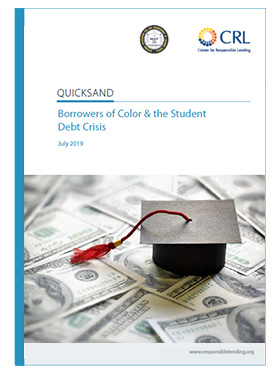Higher education has long been considered a pathway for advancement in our country. However, the playing field has not been level for low- and moderate-income families and people of color in their pursuit of a postsecondary education. Sadly, the resulting disparities in educational outcomes contribute to the persistent and growing racial wealth and income gaps. Nationwide, trends in the higher education landscape such as state disinvestment, rising college costs, the increasing necessity of college degrees in the labor market, and the loss of savings and other forms of wealth from the Great Recession have led us to a crossroads. Now, student debt threatens the well-being of an entire generation of students and their families.
Historically, access to higher education has been dramatically unequal. This pattern persists today as African-American and Latino students struggle to fund their college experiences due to broad societal discrimination. Additionally, they are too often preyed upon by poor quality for-profit institutions that fail to provide reliable educational benefits. As a result, students of color accumulate high levels of unsustainable debt.
Minority-serving institutions (MSIs) and historically-black colleges and universities (HBCUs) have a long history of providing increased opportunities in education for African American, Latino, and native students. In particular, HBCUs perform a critical function for African American undergraduates: Across the 21 states and territories where they are located, HBCUs comprise only 9% of four-year institutions but awarded 26% of all African American bachelor’s degrees in 2016. These schools, along with many public institutions, provide high-quality opportunities but have never been adequately funded. Indeed, the racial wealth and resource gap extends to institutions of higher education.
Student debt is a significant drag on the entire economy as it depresses the purchasing power of millions, preventing people from starting families, investing in their own businesses, going back to school, and buying homes. And because students of color carry larger debt burdens, these consequences also exacerbate the racial wealth divide by impacting families of color the most acutely. Without action, this problem will only worsen.
In order to ensure that our higher education system provides meaningful opportunities for students to build a financial future and participate in our economy, fundamental reforms are necessary. This report provides the historical context for the student debt crisis as both a civil rights and an economic justice issue, and provides policy solutions for borrowers in repayment, current students, and future students.
The sheer amount of outstanding debt and the number of borrowers impacted pose significant risk to this country’s eco-nomic well-being. Because of this, we must tackle the debt itself in addition to reforming the higher education system. The federal government must reinvest in our future by provid-ing broad-based debt cancellation to all borrowers in repay-ment. Further, the system must be reformed to ensure that it works efficiently and is fair for borrowers with remaining debt and for future students.
